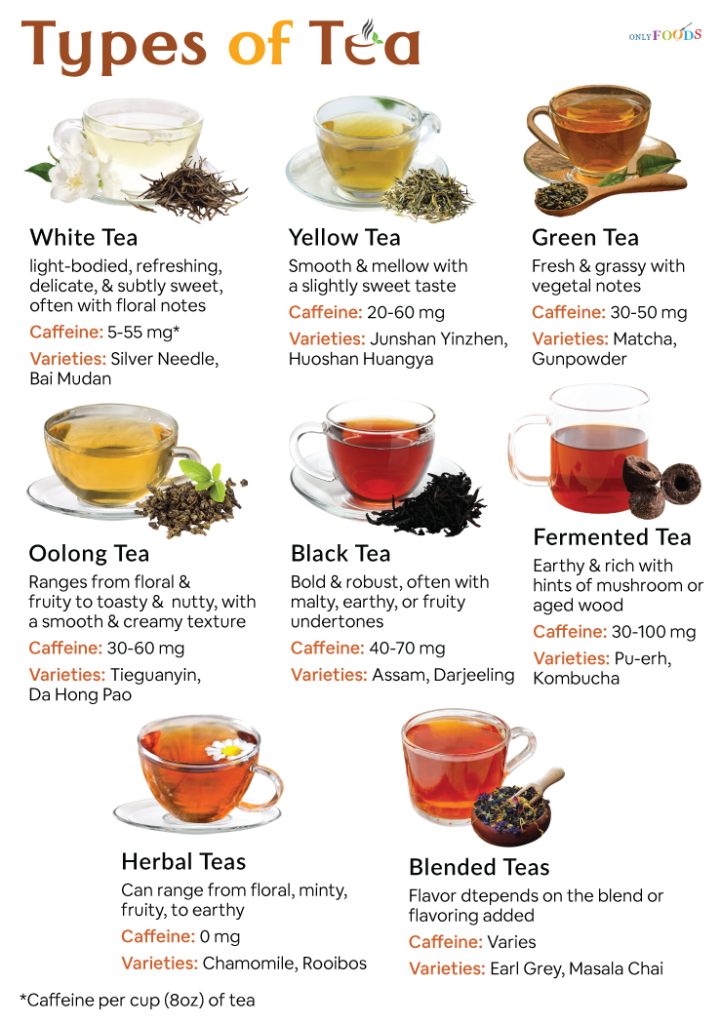Types of Tea
Tea, ranking second only to water as the most popular drink globally, has a rich history dating back to ancient times. Made from the leaves of the Camellia sinensis plant, which is native to Eastern and Southeastern Asia as well as the Indian subcontinent, tea has evolved significantly over the centuries. Today, two main varieties of the Camellia sinensis plant, namely C. s. var. sinensis and C. s. var. assamica, are cultivated worldwide for tea production.
Typically, the drink is prepared by pouring hot or cold water over the buds and leaves of the tea plant. While thousands of tea varieties are enjoyed worldwide, they all stem from about half a dozen main types distinguished by the processing of the leaves.
Classifying Teas
After being harvested, the fresh leaves, buds, and young stems undergo several processing stages before reaching the supermarket shelves as tea. It’s important to note that not all types of tea go through the same stages or in the same order.
- Wilting (Withering): Following harvest, the leaves are laid out for 8 to 14 hours to dry under the sun or in a well-ventilated room known as a withering room. This process, called wilting, results in the leaves losing approximately 35% of their moisture content.
- Bruising (Disruption): This refers to the process of bruising or tearing the leaves to break them down and release the juices that help with the next oxidation stage to bring out the flavors.
- Oxidation (Fermentation): Once the leaves are ready, they are allowed to undergo oxidation, leading to a darkening in color. The nature and duration of this process determine the distinct flavor profiles of various teas. For instance, black tea is fully oxidized, but white tea is not.
- Fixation: Once the tea leaves attain the desired oxidation level, they are heated to stop the oxidative enzymes from working further.
- Yellowing (Sweltering): This offers an alternate step in processing fresh tea leaves. It involves lightly heating the green leaves in a closed container to induce a yellow hue and enhance their flavor.
- Drying: Air drying, sunning, baking, and panning are some of the most common ways of drying the tea leaves once they are ready for grading and packaging.
- Curing (Aging): An additional step that is only required for certain teas to make them palatable or enhance flavors.
List of the Different Types of Tea
Now that you have a basic understanding of the principal stages of processing tea leaves, it is time to talk about the actual types and what sets them apart from the rest.
| Name | Stages of Processing | Caffeine/Cup (8 oz) | Flavor Profile | Common Varieties |
|---|---|---|---|---|
| White Tea | Drying | 5-55 mg | Light-bodied, refreshing, delicate, and subtly sweet, often with floral notes | Silver Needle, Bai Mudan, Baihao Yinzhen |
| Yellow Tea | Wilting, Yellowing, Drying | 20-60 mg | Smooth and mellow with a slightly sweet taste, similar to green tea but with a more complex flavor profile | Junshan Yinzhen, Huoshan Huangya, Mengding Huangya |
| Green Tea | Fixation, Rolling, Drying | 30-50 mg | Fresh and grassy with vegetal notes | Matcha, Gunpowder, Sencha, Genmaicha |
| Oolong Tea | Withering, Bruising, Partial Oxidation, Fixation, Rolling, Drying | 30-60 mg | Ranges from floral and fruity to toasty and nutty, with a smooth and creamy texture | Tieguanyin, Da Hong Pao, Dong Ding |
| Black Tea | Wilting, Bruising, Oxidation, Fixation, Rolling, Drying | 45-70 mg | Bold and robust, often with malty, earthy, or fruity undertones, offering a full-bodied and strong flavor profile | Assam, Darjeeling, Ceylon, Golden Monkey |
| Fermented (Dark) Tea | Wilting, Bruising, Oxidation, Fixation, Rolling, Fermentation | 30-100 mg | Earthy and rich with hints of mushroom or aged wood, sometimes exhibiting a sweet aftertaste with a strong and distinctive flavor | Pu-erh, Kombucha, Doncha |
| Blended (Flavored) Teas | Varies | Varies | Depends on the blend or flavoring added, ranging from floral and fruity to spicy or sweet | Earl Grey, English Breakfast, Masala Chai, Jasmine |
| Herbal Teas | Mostly drying and blending, but there may be variations | 0 mg | Can range from floral, minty, fruity, to earthy, based on the type and ingredients | Chamomile, Peppermint, Rooibos |
It is important to note that herbal teas are not true teas as they don’t contain tea leaves. The name comes mainly from the similarity in the preparation method of the drink, as herbal teas also call for steeping flowers and other herbal ingredients in hot water. For that reason, they are included in the list.
All these variations and styles have also given rise to tea-based beverages, like bubble tea, Thai tea, iced tea, and butter tea.
FAQ
Though it is a matter of personal preference, black teas like Earl Grey and English Breakfast tea are traditionally the most preferred types among the British population.

